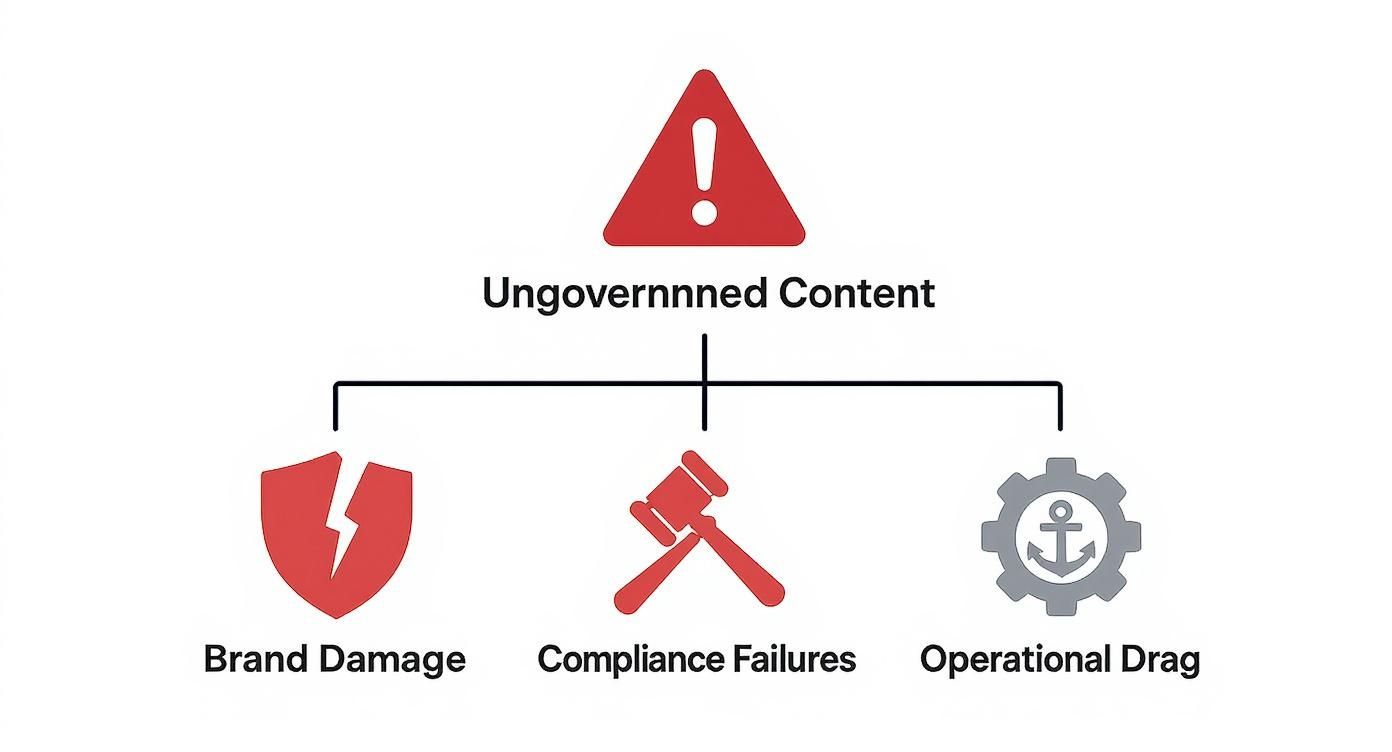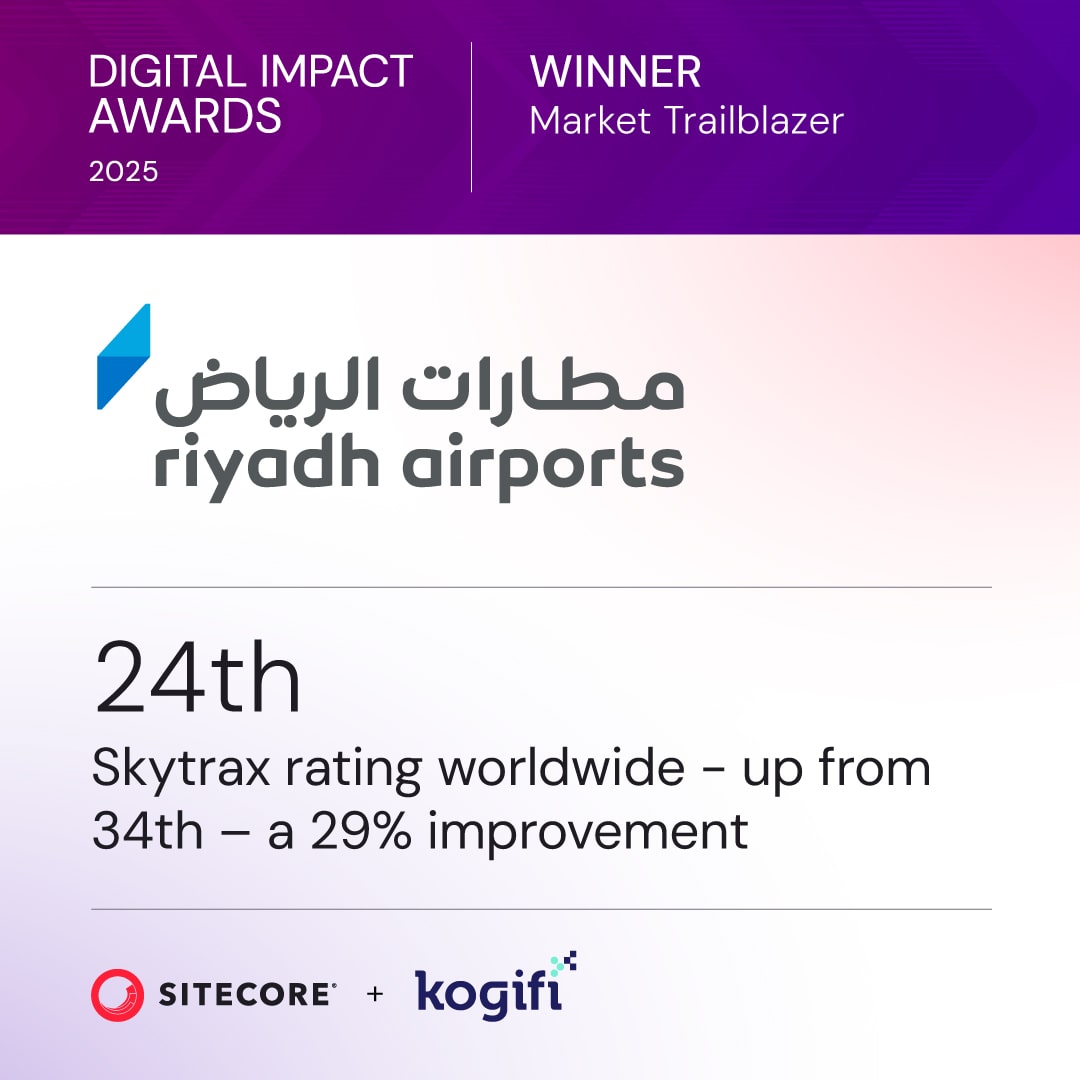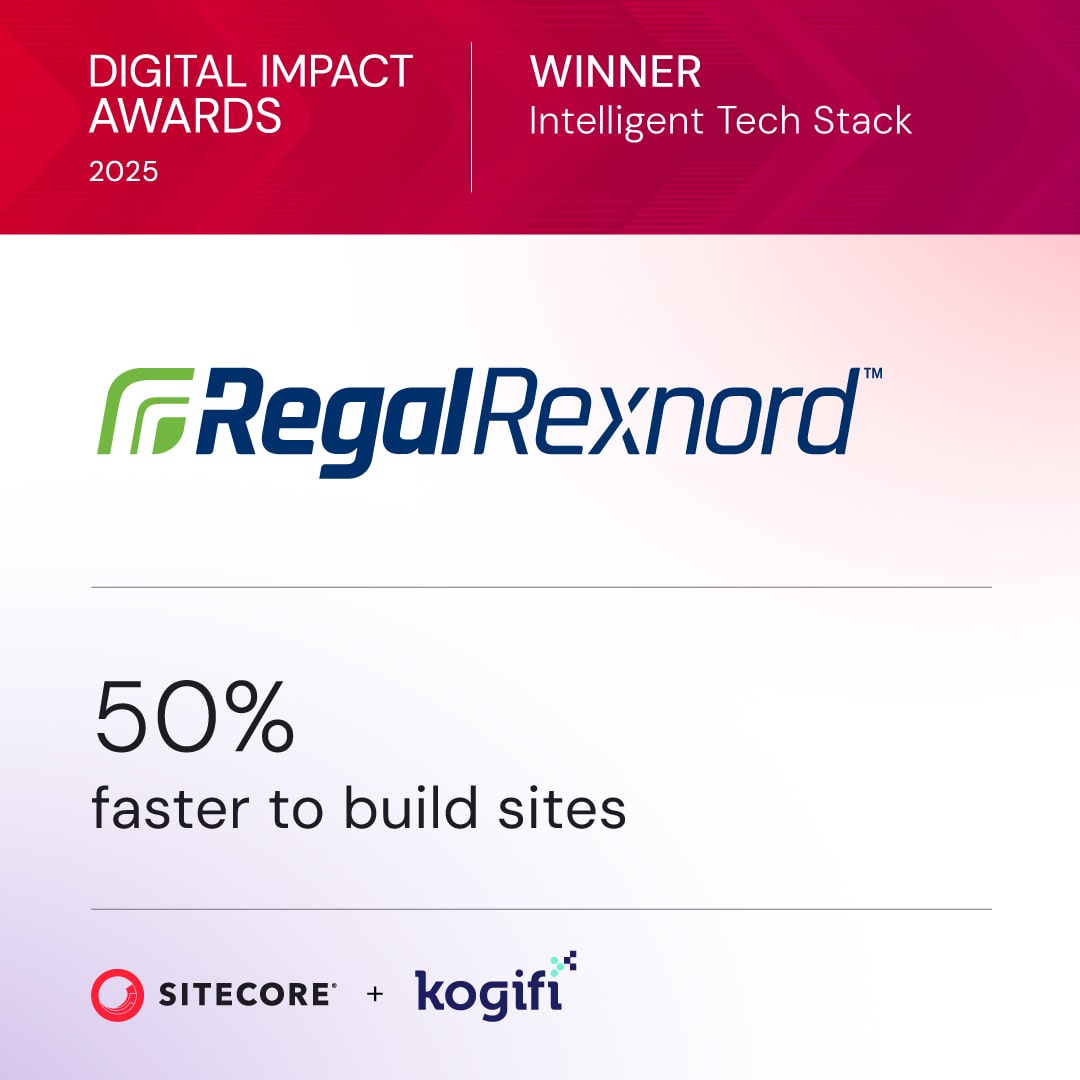A content governance framework is the system of rules, roles, and processes your organization uses to create, manage, publish, and eventually archive its content. Think of it as the central command for all your digital assets, making sure everything from a blog post to a product description stays consistent, compliant, and on-brand.
Without one, content creation often spirals into chaos.
Why Content Governance Is No longer Optional
Imagine your company’s content is a massive, sprawling warehouse. Without a proper management system, anyone can add, move, or take things off the shelves. Boxes are unlabeled, products expire without anyone noticing, and different departments create their own conflicting inventory lists.
This is exactly what it’s like to operate without a content governance framework—a state of unchecked digital chaos that leads to brand damage, compliance failures, and a serious drag on operations.
In this environment, making it up as you go just doesn't work anymore. The explosion of AI-generated content adds another layer of complexity, making it easier than ever to pump out huge volumes of inconsistent or inaccurate material. On top of that, customers now expect a seamless, trustworthy experience at every turn, which is impossible to deliver when your content is a mess.
Shifting from Restriction to Enablement
Many teams hear "governance" and immediately think of a restrictive bottleneck—a bunch of rules designed to slow down creativity. That’s an outdated way of looking at it. A modern content governance framework is actually a strategic tool for growth and risk management. It provides clarity, not constraints.
Instead of slowing things down, a good framework actually speeds up content delivery by:
- Defining clear ownership so everyone knows exactly what their role is.
- Automating approval workflows to get rid of manual hand-offs and delays.
- Providing standardized templates that lock in brand consistency from the very start.
This kind of structure is absolutely vital in complex enterprise systems. A composable DXP like Sitecore, for instance, relies on governed content to power its personalization and omnichannel features. Without governance, the platform’s potential is wasted on inconsistent and unreliable assets. The first step to building this structure is understanding what you gain from it. You can learn more about the significant advantages in our detailed guide on the benefits of enterprise content management.
A well-implemented content governance framework transforms your content operations from a reactive, chaotic scramble into a proactive, strategic function that drives business value and mitigates risk.
The Urgent Need for Structure
Despite how critical it is, adoption is still alarmingly low. A shocking 12% of marketing-growth leaders have a comprehensive content governance approach in place. This reveals a massive gap between knowing there's a problem and actually fixing it.
It also leaves tons of organizations exposed to unchecked, non-compliant content that just doesn't meet modern standards for accuracy and transparency. As new data shows, content governance is a must-have for tech firms. This gap highlights why putting a framework in place is no longer a choice—it's a business imperative for survival and growth.
The Four Pillars of an Effective Governance Framework
A solid content governance framework isn’t some dusty rulebook you write once and forget. It’s a living, breathing system built on four interconnected pillars. Get the balance right, and you create a structure that supports quality, consistency, and compliance. But if you neglect even one, the whole thing can wobble and fall apart.
These pillars are People, Process, Standards, and Technology. Each one answers a critical question: Who’s in charge? How do we get things done? What are the rules? And which tools keep us honest?
The infographic below shows exactly what happens when content runs wild—brand damage, compliance nightmares, and a serious drag on operations. It’s a stark reminder of why these four pillars are so essential.

This really drives home how a lack of structure can turn your content from a valuable asset into a major business liability.
Pillar 1: People and Roles
The bedrock of any governance model is putting the right people into clearly defined roles. Without clear ownership, accountability devolves into a game of hot potato, stalling projects and creating a mess of inconsistent content. A well-defined structure ensures everyone knows exactly how they contribute to the content lifecycle.
Putting names to responsibilities is the first step toward building an accountable and efficient content operation. Here’s a look at the essential players and what they do.
Key Roles in a Content Governance Framework
In a platform like Sitecore, these roles aren't just titles on an org chart. They're mapped directly to user accounts with specific permissions, meaning a Content Creator literally can't publish without an Approver's consent. This is how abstract roles become practical, system-enforced responsibilities.
Pillar 2: Process and Workflows
This pillar is all about the "how." It maps out the entire journey your content takes, from a bright idea scribbled on a napkin to its eventual retirement. A documented process kills ambiguity and makes your content engine predictable, scalable, and efficient.
A common myth is that process kills creativity. The truth is, a clear process frees creators from logistical headaches, letting them focus on what they do best: creating great content.
A typical content workflow moves through several key stages:
- Ideation: An idea is generated or a formal request is submitted.
- Creation: The assigned creator drafts the content based on the brief.
- Review: The draft goes to SMEs and editors for accuracy and quality checks.
- Approval: The content is sent to the final approvers, like legal or brand, for the green light.
- Publication: Once approved, the content goes live on its designated channels.
- Maintenance: Content is periodically reviewed and updated to stay relevant.
- Archival: Outdated content is pulled from public view.
Within Sitecore, this entire process can be automated using its powerful workflow engine. A new blog post, for instance, can be set up to automatically move from a "Draft" state to a "Review" state, pinging the next person in the chain. This built-in automation is a cornerstone of effective governance, making it nearly impossible for unapproved content to slip through the cracks.
Pillar 3: Standards and Policies
Standards are the specific, non-negotiable rules that dictate the quality and consistency of your content. They're the detailed instructions ensuring that every blog post, video, and landing page—no matter who created it—feels like it came from the same brand.
This is where you write down everything from your high-level messaging principles to the nitty-gritty details.
Key standards you absolutely need to document include:
- Brand Voice and Tone Guide: Defines your content's personality. Are you an authoritative expert, a friendly guide, or a playful innovator?
- Style Guide: The rulebook for grammar, punctuation, and formatting that keeps everything consistent.
- SEO Checklist: Outlines the must-haves for keywords, meta descriptions, and alt text to get your content seen.
- Accessibility Guidelines: Ensures your content is usable by everyone, typically by following standards like WCAG.
- Metadata Policy: Defines how content should be tagged for search, filtering, and personalization. To make sure your efforts are paying off, you need to track the right metrics; learn more in our guide to content KPIs for enterprise CMS platforms.
Pillar 4: Technology and Tools
Technology is the pillar that brings the other three to life. It’s the enforcement engine. The right platform automates your workflows, manages permissions, and makes it incredibly simple for your team to follow the rules you’ve established.
For enterprises, the Sitecore ecosystem and Microsoft SharePoint are central to this pillar.
- Sitecore is the gold standard for governing the customer-facing digital experience. Its composable suite—including XM Cloud, Content Hub, and DAM—provides granular user roles, multi-step workflows, and structured content templates built to enforce governance from content ideation to publication.
- SharePoint often handles the internal side, governing the document lifecycle for collaborative assets. It uses version control, approval workflows, and retention policies to manage files before they even make their way into a public-facing DXP like Sitecore.
When these four pillars work in harmony, they create a robust content governance framework that transforms chaotic content operations into a controlled, strategic asset for your business.
Activating Your Governance Model in Sitecore
A content governance framework on paper is just that—a document. It only comes to life when you plug it into a powerful engine like Sitecore. This is where your abstract rules about brand voice, legal reviews, and content ownership become real, automated guardrails that steer your creators toward producing great work. Sitecore isn't just a place to publish content; it's a platform built to enforce your governance model from the ground up.

Putting your framework into practice means configuring Sitecore’s core features to reflect your people, processes, and standards. This practical step turns a static plan into a dynamic, living system that actively manages your entire digital experience. Let's dig into how to make that happen.
Building Your Guardrails with Roles and Permissions
First things first, you need to mirror your governance roles directly within Sitecore’s Security Editor. This is where you go beyond the org chart and assign concrete permissions that dictate who can do what, where, and when. Getting this granular control right is the foundation for everything else.
Think of it like setting up access levels in a high-security building. A junior content creator might have a keycard that only opens the "Drafting" room. A senior editor’s card, on the other hand, opens the "Review" and "Approval" rooms, too.
In Sitecore, this translates into specific roles:
- Content Authors: They can create and edit content, but they can't publish it live. Their access is usually limited to specific sections of the content tree.
- Content Editors/Approvers: With more permissions, they can review drafts submitted by authors, make necessary tweaks, and push content to the next stage.
- Publishers: These are your final gatekeepers. They have the authority to approve content and push it to the live website for the world to see.
- Administrators: They hold the keys to the kingdom, with full control to handle system maintenance and configure the governance rules themselves.
This structure makes it virtually impossible for an unapproved piece of content to slip through the cracks and go live, creating a powerful first line of defense.
Automating the Content Lifecycle with Workflows
With roles clearly defined, the next step is to automate your processes using Sitecore Workflows. A workflow is simply a predefined series of steps that a piece of content must move through before it can be published. This feature is the heart of content governance in Sitecore because it automates the handoffs and approvals that so often create bottlenecks.
A well-configured Sitecore workflow doesn't just manage content; it orchestrates collaboration. It automatically notifies the right people at the right time, creating a clear, auditable trail of every action taken.
A typical content workflow might look something like this:
- Draft: An author creates the new content.
- Awaiting Review: The author submits the item, which locks it from further edits and pings a Content Editor.
- Awaiting Approval: The editor gives it the green light, sending it to the legal or brand team for a final check.
- Ready to Publish: Once all parties sign off, the content moves to a final state, and a Publisher gets notified.
- Published: The content is live on your site.
This kind of automation eliminates the endless email chains and manual follow-ups, ensuring your process is followed to the letter, every single time. It also gives you a complete history of who approved what and when—something that’s invaluable for compliance and accountability.
Enforcing Consistency with Templates and Standard Values
The final piece of the puzzle is enforcing your brand and structural standards. In Sitecore, this is handled through Data Templates and Standard Values. A data template is the blueprint for a piece of content, defining all the fields it must include. For instance, a "Blog Post" template might require a title, author, main body text, and a meta description.
This simple setup ensures that creators can't forget critical information, like SEO metadata or accessibility tags. Standard Values take it a step further by pre-populating certain fields with default content. You could set a standard author, apply a default classification tag, or even insert placeholder text that guides the creator on tone and style.
Together, these features guarantee that every piece of content starts from a brand-compliant baseline, which drastically reduces inconsistencies down the line. This structured approach is fundamental to managing an efficient and scalable content supply chain where quality is built-in from the very beginning. By activating these features, you transform Sitecore from a simple CMS into a true governance platform that actively upholds the integrity of your digital presence.
Governing Documents and Collaboration in SharePoint
While Sitecore is the star of the show for your public-facing digital experience, great content rarely starts there. The real work—the drafting, debating, and refining—often happens behind the scenes in collaborative spaces like SharePoint. This is why a solid content governance framework can't just focus on the final product; it has to reach all the way back to the very first draft.
Think of SharePoint as the clean, organized workshop where raw materials are prepped before they’re sent to the main factory (Sitecore) for final assembly. If the workshop is a mess, you’ll inevitably send flawed parts down the production line, leading to costly rework and delays. By applying governance here, you ensure only top-quality, approved assets ever make it to your customer-facing platforms.

This means your governance strategy really has two jobs: one for internal collaboration and another for external publishing. Get them both right, and you create a seamless, end-to-end content supply chain.
Structuring Content at the Source
The first step in governing SharePoint is creating a structure that naturally guides people toward consistency. This starts with Document Libraries, which need to be treated as more than just a digital filing cabinet.
An effective setup includes:
- Mandatory Metadata: Don't make it optional. Require users to tag every document with key info like department, content type, review date, and owner. This is what makes assets findable and fuels automated workflows.
- Content Types: Instead of generic "documents," define specific templates for things like a "Press Release," "Policy Document," or "Marketing Brief." Each content type can have its own metadata fields and workflow, locking in consistency from the start.
- Versioning Controls: Turn on major and minor versioning. This creates a clear history of edits, which is a lifesaver for audit trails and lets you roll back to a previous version if something goes wrong.
This kind of structure turns a potentially chaotic file share into a predictable, well-organized library where quality is enforced from the moment a file is created.
Automating Lifecycles and Approvals
One of SharePoint’s biggest strengths is its ability to automate a document's journey, making sure nothing slips through the cracks. This is where your governance policies stop being passive guidelines and become active, automated processes.
A well-governed SharePoint environment doesn't just store documents; it actively manages their journey from creation to archival, ensuring compliance and reducing manual oversight every step of the way.
You can set up approval workflows that automatically send critical documents—like legal contracts or financial reports—to the right people for sign-off. A document simply can't move to a "final" or "approved" state until the designated reviewers have given their explicit consent.
On top of that, retention policies are crucial for compliance and keeping things tidy. You can create rules that automatically archive or delete documents after a certain period. This reduces clutter and minimizes the risks that come with holding onto outdated information. To really get this right, exploring digital asset management best practices can offer some valuable pointers for refining your approach.
Integrating with Microsoft Purview for Advanced Security
To take your SharePoint governance to the next level, integrating it with Microsoft Purview is a must. Purview adds a sophisticated layer of data loss prevention (DLP) and compliance capabilities, acting as an intelligent security guard over your content.
Purview can automatically scan documents and identify sensitive information, like financial data or personally identifiable information (PII). Based on the rules you set, it can then:
- Block sharing of sensitive files with anyone outside your organization.
- Display policy tips that pop up to educate users about compliance rules in real-time.
- Apply sensitivity labels that automatically encrypt documents and restrict access.
By connecting SharePoint with Purview, you're building a powerful defense against data breaches and compliance headaches. This integration ensures your internal collaboration space isn't a weak link but a fortified starting point for your entire content strategy, feeding clean, compliant, and approved content into Sitecore and beyond.
Future-Proofing Your Framework for AI and Compliance
A static content governance framework is an obsolete one. With the explosion of generative AI and an ever-tightening net of global regulations, your governance model has to be a living, breathing system. It needs to be built for change, ready to absorb new tech and respond to new legal demands without shattering your workflows.
This isn't just about keeping up with trends; it’s about survival. A future-proof framework doesn't just react—it anticipates. It bakes in guidelines for emerging tools like AI while creating the auditable paper trails needed to keep regulators happy. This turns governance from a defensive chore into a forward-thinking strategy that shields your organization from tomorrow's risks.
Integrating AI with Clear Guardrails
Generative AI can scale content creation at an incredible pace, but without rules, it’s a direct threat to your brand’s integrity and accuracy. Bringing AI into the fold responsibly means adding a new layer to your content governance framework that specifically dictates how it can be used. This isn't about banning AI; it’s about setting clear, enforceable boundaries.
Your AI governance policies should lay out the ground rules:
- Disclosure Standards: Define when and how your audience must be informed that content was created with AI assistance. Transparency is key.
- Fact-Checking Protocols: Any claim, statistic, or data point generated by AI must be verified by a human expert before it ever sees the light of day.
- Brand Voice Alignment: AI outputs are a starting point, not a finished product. They must be edited to perfectly match your established brand tone and style.
- Data Security Rules: Strictly prohibit employees from pasting sensitive company or customer data into public AI models. It’s a recipe for a data leak.
These guardrails let you tap into AI's power without sacrificing the quality, accuracy, and trust you’ve worked so hard to build.
Navigating the High Stakes of Regulatory Compliance
While technology races forward, the regulatory landscape is getting more and more complex. The European Union's AI Act is a prime example, setting a global benchmark with steep financial penalties that make compliance an immediate priority.
The EU AI Act brings fines of up to €35 million or 7% of global turnover—whichever is higher. That kind of money makes compliance a financial necessity, not just a "nice-to-have." This strict approach is a world away from the United States, where AI governance frameworks are still mostly voluntary and piecemeal.
A rock-solid governance framework is your best line of defense. By enforcing standardized workflows, approvals, and content lifecycles in platforms like Sitecore and SharePoint, you automatically create a complete, auditable trail. This record proves who approved what content and when, demonstrating that you followed compliant processes. That documentation becomes priceless when regulators start asking questions. For a deeper dive, check out our guide on AI in multi-cloud compliance monitoring.
Modern governance isn’t just about keeping your brand consistent. It’s about building a legally defensible content operation that can withstand regulatory scrutiny.
This proactive approach to compliance is the only way to sidestep massive financial and reputational damage. If you're looking to build out more robust strategies, the principles of Artificial Intelligence Governance offer a great starting point.
Ultimately, a governance model that evolves with both technology and regulation is one that builds resilience. It ensures your content operations remain a strategic asset, not a ticking liability.
Answering Your Content Governance Questions
Even the best-laid plans come with questions. When you’re introducing a new system like a content governance framework, it's natural for your team to have a few. Let's tackle some of the most common ones head-on and show how this structure is designed to bring clarity, not more complexity.
What's the Very First Step?
Before you can govern your content, you have to know what you’re working with. That’s why the first, most critical step is a comprehensive content audit.
You can't manage what you don't measure. An audit gives you a complete inventory of everything you have, shows you who the key players are, and maps out the workflows people are actually using (not just the ones on paper). It’ll quickly highlight the biggest pain points, like glaring brand inconsistencies or potential compliance risks. This groundwork is essential—it ensures the framework you build solves real problems from day one.
How Do We Get Everyone on Board?
Getting organizational buy-in isn't about forcing new rules on people. It's about showing each department how governance makes their job easier and protects the company as a whole. Frame it in terms of what they care about most.
- Marketing gets stronger brand consistency and can launch campaigns faster.
- Legal sees a massive reduction in compliance risks.
- IT gets a more stable, predictable platform to manage.
Show them how the framework is designed to eliminate rework and make collaboration smoother. A great way to build momentum is to start with a small pilot project. Once you demonstrate a few clear, tangible wins, getting wider adoption becomes much easier.
Won't a Governance Framework Just Slow Us Down?
A poorly designed one absolutely can. But a good one does the exact opposite—it acts as an accelerator by getting rid of ambiguity.
When you have clear roles, documented standards, and automated workflows in a tool like Sitecore, you eliminate the endless email chains and guesswork that plague so many content teams. Creators know exactly what’s expected of them from the start, which makes the entire process from draft to publication move much faster.
The goal is to provide 'freedom within a framework.' This structure enables speed and agility by ensuring everyone works from the same playbook, allowing teams to focus on creating high-quality content instead of navigating chaotic processes. A well-implemented governance model is an accelerator, not a brake.
Ultimately, that clarity empowers your teams to produce better content, faster.
Ready to transform your content operations from chaotic to controlled? The experts at Kogifi specialize in implementing robust content governance frameworks within Sitecore and SharePoint, turning your digital strategy into a powerful, efficient engine for growth. Learn how we can help you build a scalable and compliant digital experience.























.jpeg)
















